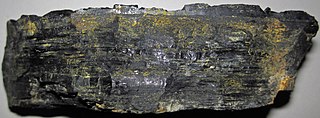This article contains a list of fossil-bearing stratigraphic units in Washington D.C., U.S.
| Group or Formation | Period | Notes |
|---|---|---|
| Arundel Clay | Cretaceous | |

Megalonychidae is a group of sloths including the extinct Megalonyx. Megalonychids first appeared in the early Oligocene, about 35 million years (Ma) ago, in southern Argentina (Patagonia). There is actually one possible find dating to the Eocene, about 40 Ma ago, on Seymour Island in Antarctica. They first reached North America by island-hopping across the Central American Seaway, about 9 million years ago, prior to formation of the Isthmus of Panama about 2.7 million years ago. Some megalonychid lineages increased in size as time passed. The first species of these were small and may have been partly tree-dwelling, whereas the Pliocene species were already approximately half the size of the huge Late Pleistocene Megalonyx jeffersonii from the last ice age.
Protosiren is an extinct early genus of the order Sirenia. Protosiren existed throughout the Lutetian to Priabonian stages of the Middle Eocene. Fossils have been found in the far-flung locations like the United States, Africa (Egypt), Europe and Asia.
Cornwallius is an extinct herbivorous marine mammal of the family Desmostylidae. Cornwallius lived along the North American Pacific Coast from the Early Oligocene (Chattian) through the Oligocene and existing for approximately 7.8 million years.
Dolichopareias is an extinct genus of prehistoric amphibian.

Lystrosauridae is a family of dicynodont therapsids from the Permian and Triassic time periods. It includes two genera, Lystrosaurus and Kwazulusaurus. Kwazulusaurus includes a single species, K. shakai, from the Late Permian of South Africa and Lystrosaurus includes many species from the Late Permian and Early Triassic of South Africa, India, and Antarctica.

The Washington Formation is a coal, sandstone, and limestone geologic formation in West Virginia. It preserves fossils dating back to the Permian period.

The Cuyahoga Formation is a geologic formation in Ohio. The age of the formation is difficult to determine, because of a lack of diagnostic fossils. Roughly, the formation dates from the Late Kinderhookian to the Middle Osagean. Eight members are recognized, among them the Orangeville Shale, Sharpsville Sandstone, and Meadville Shale.

The Kinzers Formation is a geologic formation in Pennsylvania. It preserves fossils dating back to the Cambrian Period.
The Cedar District Formation is a geologic formation exposed on Vancouver Island, the Gulf Islands of British Columbia and San Juan Islands of Washington (state). It preserves fossils dating back to the Campanian Epoch of the Cretaceous period. It dates to the lower mid-Campanian.
The Crescent Formation is a geologic formation in Washington (state). It preserves fossils dating back to the Paleogene period.
The Lincoln Creek Formation is a geologic formation in Washington (state). It preserves fossils dating back to the Paleogene period.
The Makah Formation is a geologic formation in Washington (state). It preserves fossils dating back to the Paleogene period.

The Pysht Formation is a geologic formation in Washington (state). It preserves fossils dating back to the Paleogene period.

The Etchegoin Formation is a Pliocene epoch geologic formation in the lower half of the San Joaquin Valley in central California.
The Chanac Formation is a Cenozoic Era sandstone geologic formation in the southeastern San Joaquin Valley, within Kern County, California.

The Puget Group is a geologic group in Washington (state). It preserves fossils dating back to the Paleogene period.
| Wikisource has original works on the topic: Paleontology in the United States#Washington, D.C. |